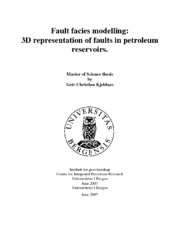| dc.description.abstract | The purpose of a reservoir model is to act as a tool for optimizing development and production strategies for subsurface hydrocarbon reservoirs. Such a model is intended to be predictive, and to act as a map for the ones placing and drilling wells into the reservoir. For a model to be as predictive as possible, it is important that it represents the geology as accurately as possible. In present day models faults are modelled as 2D transmissibility multipliers. Such a representation is not optimal as it excludes the effect the actual 3D architecture of faults have on fluid flow. To rectify this, a technique to model faults as 3D bodies has been developed by the Fault Facies group at CIPR. The aim of this thesis was to conduct a practical test of the fault facies modelling method. The work is a part of the Fault Facies groups' effort to improve the modelling technique. My assignments in the project can be summarised as follows: 1. Recreate reservoir models previously presented by Sæther (2006), and use these as a base for the test. The models were reproduced geometries mapped at Kilve on the South coast of the Bristol Channel (UK). Simulation results for these models, using conventional methods, were available, thus allowing comparison with results obtained from the fault facies modelling. 2. Beta-testing of the fault facies modelling algorithms included in Havana, a fault modelling tool developed by the Norwegian Computing Center (NR)) and used in conjunction with Irap RMS^TM as a base for implementing the fault facies modelling method. The work involved identifying bugs and problems with the work flow and implementation, reporting them to NR and finding workarounds. 3. Strain- and facies modelling of fault zones. This was done using a Havana as well as scripts in the internal programming language of RMS (IPL). 4. Assign and model porosity and permeability for the fault facies. The values used were based on published and unpublished data collected by the Fault Facies group and supplemented by data from other published sources. 5. Flow simulation and testing of the models. Results were analyzed compared with simulation results obtained by Sæther (2006) using conventional fault modelling techniques. The reservoir modelling tool used to create the model grids in this assignment has been Irap RMS^TM from Roxar. This is a common standard modelling tool used in both research and the petroleum industry to generate petroleum reservoir geo- and simulation models. The ECLIPSE 100 fluid flow simulator from Schlumberger was used to perform the flow simulations. A third program, Havana (chapter 2.3), by the Norwegian Computing Centre (NR), was used to implement advanced functions needed in the modelling process. | en_US |
